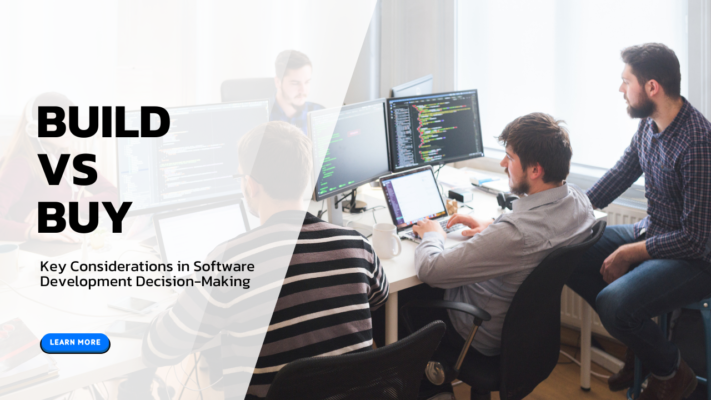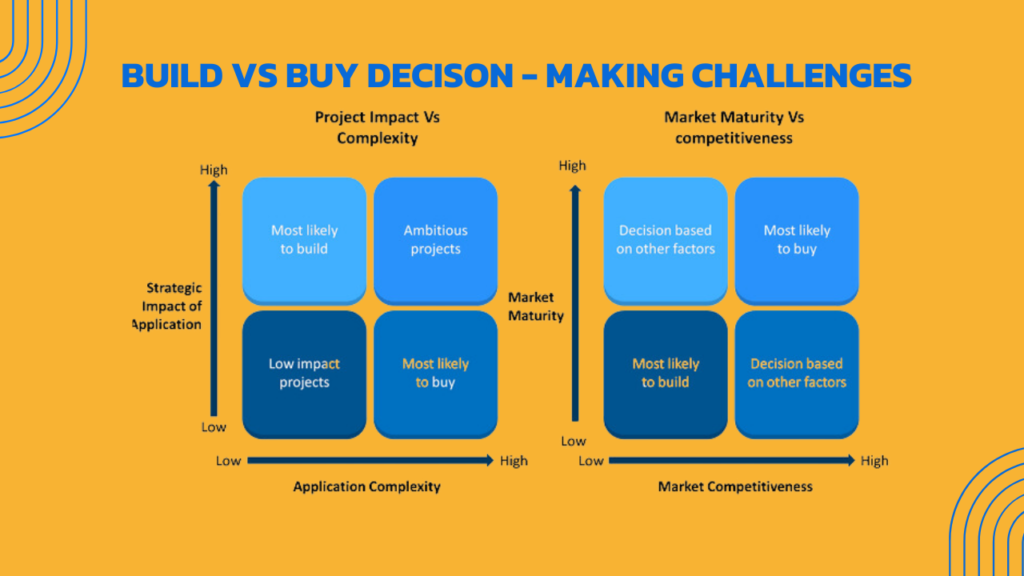
According to a recent Gartner survey, by 2025, 70% of organizations will significantly shift their approach to software development, moving from a predominantly “build” strategy to a more balanced “build vs. buy” approach. This shift is driven by the increasing complexity of business needs, the demand for faster time-to-market, and the growing availability of sophisticated off-the-shelf solutions.
Buying custom software or buying an existing solution is one of the most critical choices an organization can make. It affects the technology stack and the overall business strategy, budget, and operational efficiency. In this blog, we will explore the “build vs. buy” dilemma in detail, providing key considerations, industry insights, and practical advice to help you make the right decision for your organization.
What Does “Build vs. Buy” Mean?
At its core, the “build vs. buy” decision revolves around whether a company should develop a custom software solution internally or purchase an existing software product from a vendor. Both options have their advantages and disadvantages, and the right choice depends on several factors, including the specific needs of the business, available resources, and long-term goals.
Key Industry Insights: The Current Landscape
Gartner’s research indicates that the demand for off-the-shelf software solutions has grown significantly, with organizations increasingly opting for ready-made products that offer quick deployment and lower upfront costs. However, the same research also highlights that custom-built software still plays a crucial role in scenarios where businesses require highly tailored solutions that can adapt to unique processes and competitive differentiation.
In 2023, Forrester reported that nearly 60% of enterprises have adopted a hybrid approach, combining both build and buy strategies to address their diverse software needs. This trend underscores the importance of understanding when to build and when to buy, as well as how to strategically integrate both approaches.
Build vs. Buy: Key Considerations
When faced with the “build vs. buy” decision, businesses must carefully evaluate several factors to determine the best course of action. Below are the key considerations that should guide this decision-making process:
1. Cost Analysis
One of the most significant factors in the “build vs. buy” decision is cost. Developing custom software in-house often requires a substantial upfront investment in terms of time, money, and resources. This includes hiring or contracting skilled developers, project managers, and quality assurance professionals, as well as ongoing maintenance and support costs.
On the other hand, buying software usually involves a lower initial cost but may come with recurring subscription fees, licensing costs, and potential expenses for customization or integration with existing systems. It’s crucial to conduct a thorough cost-benefit analysis to compare the total cost of ownership (TCO) for both options over the long term.
2. Time-to-Market
In today’s fast-paced business environment, the speed at which a solution can be deployed is often a critical factor. Off-the-shelf software typically offers a quicker time-to-market, as it is already developed, tested, and ready for implementation. This can be particularly advantageous for businesses that need to respond swiftly to market changes or seize new opportunities.
Conversely, building custom software can be a time-consuming process, potentially delaying the launch of the solution. However, the benefit of a custom-built solution is that it can be designed to meet specific business needs from the outset, potentially offering a more competitive edge in the long run.
3. Customization and Flexibility
Customization is another key consideration in the “build vs. buy” decision. Off-the-shelf software solutions are designed to cater to a broad audience, which means they may not perfectly align with your business processes or requirements. While many vendors offer customization options, these can be limited and may require additional costs.
Building software in-house, on the other hand, provides complete control over the design and functionality, allowing for a solution that is fully tailored to your organization’s needs. This flexibility can be crucial for businesses with unique processes or niche requirements that cannot be adequately addressed by commercial software.
4. Scalability
Scalability is a critical factor, especially for growing businesses. When choosing between “build vs. buy,” it’s important to consider how the software will scale with your business over time. Off-the-shelf solutions may offer scalability, but they might not be able to adapt to rapid growth or highly specific needs without significant customization or additional modules.
Custom-built software can be designed with scalability in mind, allowing for seamless growth and the integration of new features as the business evolves. However, this requires careful planning and a solid understanding of future needs, as scaling a custom solution can also be resource-intensive.
5. Integration with Existing Systems
The ability to integrate with existing systems is a crucial consideration in the “build vs. buy” debate. Many businesses rely on a variety of software applications to manage their operations, and it’s essential that any new solution can seamlessly integrate with these systems.
Off-the-shelf software often comes with built-in integrations for popular platforms and tools, making it easier to connect with your existing tech stack. However, these integrations may not always be as deep or flexible as needed. Custom-built software, while potentially more challenging to integrate, can be designed specifically to work with your existing systems, ensuring a more cohesive and efficient workflow.
6. Maintenance and Support
Ongoing maintenance and support are critical factors to consider when deciding between “build vs. buy.” Off-the-shelf software typically comes with vendor-provided support, including regular updates, bug fixes, and customer service. This can reduce the burden on your internal IT team and ensure that the software remains up-to-date with the latest features and security patches.
In contrast, custom-built software requires ongoing maintenance and support from your development team or a third-party provider. This can be more resource-intensive, but it also offers greater control over how the software is maintained and updated, allowing you to prioritize features and fixes that are most important to your business.
7. Risk Management
Risk management is an essential consideration in the “build vs. buy” decision. Off-the-shelf software solutions often carry lower risk because they are developed, tested, and used by many organizations. The vendor assumes much of the risk associated with development and maintenance.
Building custom software, however, involves a higher level of risk, particularly if the project is complex or requires cutting-edge technology. The development process can encounter unforeseen challenges, such as delays, budget overruns, or technical difficulties. However, the potential reward is a solution that perfectly fits your needs and can provide a significant competitive advantage.
8. Control and Ownership
When you buy software, you typically license it from the vendor, meaning you do not own the source code or have full control over the software’s future development. This can be a limitation if the vendor discontinues the product, changes pricing, or no longer meets your needs.
Building your software gives you complete control and ownership of the source code, allowing you to make any changes or enhancements as needed. This level of control can be advantageous for businesses that require a highly customized solution or want to retain full ownership of their technology assets.
Build vs. Buy: Real-World Use Cases
To further illustrate the “build vs. buy” decision-making process, let’s look at some real-world use cases:
1. Financial Services: A large financial institution might choose to build a custom trading platform to meet its specific regulatory requirements and trading strategies. The need for high security, scalability, and proprietary algorithms makes a custom solution the best choice.
2. Healthcare: A small healthcare startup may opt to buy an off-the-shelf electronic health record (EHR) system to quickly comply with industry standards and provide immediate value to its users. The ability to deploy quickly and access ongoing support outweighs the need for customization.
3. Retail: An e-commerce company might use a hybrid approach, buying a commercial platform for core functions like inventory management and payment processing, while building custom features for personalized customer experiences and advanced analytics.
4. Manufacturing: A manufacturing company may decide to build a custom ERP system that integrates with its unique production processes and legacy systems. The ability to tailor the software to specific operational needs provides a competitive advantage.
When to Build vs. When to Buy: A Strategic Framework
Determining when to build vs. buy requires a strategic framework that considers the following factors:
1. Business Objectives: Align the decision with your long-term business goals. If the software is critical to your competitive advantage, building may be the better option.
2. Resource Availability: Assess your internal capabilities and resources. If you have the technical expertise and budget, building custom software may be feasible.
3. Time Constraints: Consider the urgency of the project. If you need a solution quickly, buying off-the-shelf software may be the best choice.
4. Future Flexibility: Evaluate how important it is to have control over the software’s future development. If you need flexibility and ownership, building is the way to go.
5. Risk Tolerance: Understand your organization’s risk tolerance. If you prefer to minimize risk, buying a proven, off-the-shelf solution may be more appropriate.
The Future of Build vs. Buy: Emerging Trends
As technology continues to evolve, the “build vs. buy” debate will become even more nuanced. Emerging trends in artificial intelligence (AI), machine learning, and low-code/no-code platforms are transforming the software development landscape. According to Gartner, by 2025, 80% of technology products and services will be built by people who are not technology professionals, further blurring the lines between building and buying.
Low-code and no-code platforms are making it easier for businesses to build custom software without the need for extensive coding expertise. These platforms offer a middle ground between building and buying, allowing organizations to create tailored solutions with greater speed and flexibility.
Conclusion: Navigating the Build vs. Buy Decision with Upcore Technologies
The “build vs. buy” decision is complex and multifaceted, requiring careful consideration of various factors, including cost, time-to-market, customization, scalability, integration, maintenance, risk, and control. There is no one-size-fits-all answer, and the right choice depends on your organization’s unique needs and goals.
At Upcore Technologies, we understand the challenges businesses face when navigating the build vs. buy dilemma. Our team of experts is here to help you make informed decisions, whether you’re looking to develop custom software that provides a competitive edge or seeking an off-the-shelf solution that meets your immediate needs.
With our extensive experience in software development, we offer a comprehensive range of services, from custom software design and development to integration with existing systems. We also provide strategic consulting to help you weigh the pros and cons of building vs. buying, ensuring that your decision aligns with your business objectives and delivers the best possible outcomes.
Ready to explore your options? Contact Upcore Technologies today to learn how we can support your software development journey, whether you’re building, buying, or exploring a hybrid approach. Let’s work together to create solutions that drive your business forward.











